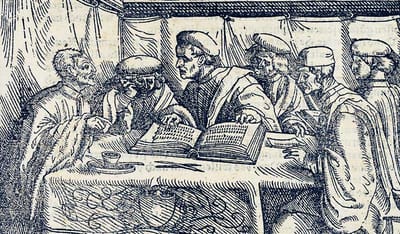
The concept of academic freedom in the U.S. famously finds its origins in Germany in the 19th century, and the concept of Lehrfreiheit (freedom to teach) and Lernfreiheit (freedom to learn). Both of these were new concepts when introduced in the early 19th century in Germany by Wilhelm von Humboldt, and they were radical when imported into the new research university taking shape in the U.S. in the late 19th century. Lehrfreiheit would give rise to the American concept of “academic freedom,” while Lernfreiheit would give rise to the innovations of majors, electives, and student agency in their own education. All of this my generation took for granted, imagining such freedoms to be so deeply ingrained in higher education as to be inviolable. As we are finding out, academic freedom is much more fragile than we have often imagined.[[1]] It is also, I will argue, much less firmly grasped than we often imagine.
[[1]]: Down the road I want to return to the subject of the erosion of Lernfreiheit, as the hyperprofessionalization of majors and the erosion of elective opportunities at many research universities has increasingly limited choice and flexibility in the course of study of 21st-century undergraduates.
It is fair to say that many professors—the beneficiaries of this remarkable privilege—have confused notions as to what exactly it entails. In normal times, this was rarely a problem. True, professors might imagine that their every utterance in class or out was protected by academic freedom, and the fact that this was not in fact the case did not result in significant pushback from the university or the public. That of course started to change in the last couple of decades, and now in 2025 the climate is such that defining academic freedom is more urgent than ever.
I would argue it always should have been urgent. To expand the notion of academic freedom beyond its core definition , as we have in the U.S. from the very beginning, was always to dilute it. It was the equivalent of being gifted with a walled preserve in which to farm in peace, only to start planting crops outside the walls, further and further, assuming always that those original walls would somehow continue to protect all. Anyone who has ever played a game of Civilization knows how that works out.
That said, the boundaries of our walled preserve were muzzy from the start due to several factors I will try and untangle in this series of notes. For now, those complicating factors would have to include:
- The preexistence in the U.S. of a constitutional protections for free speech enshrined in the first amendment to the Bill of Rights, but one which had itself been rarely explored in the courts at the time of academic freedom’s arrival.
- The contemporaneous rise of the labor movement in the U.S., confusing academic freedom with worker’s rights issues.
- The growing demand for faculty in the early 20th century, as universities mushroomed in number and scope following the Morrill Acts, the mass movement of populations West fueled by by the railroads, and the institutionalization of the PhD as a terminal degree for the professoriate.
- The rise of tenure in the 1940s as the primary tool to secure academic freedom, about which much more later.
- The arrival of academic freedom in the midst of ongoing culture wars—primarily focusing around Darwinism and Marxism—playing out very differently in different state and institutional contexts.
Before getting into the untangling of these historical strands, it seems worthwhile to start with the definition of academic freedom as first articulated in the founding statement of the American Association of University Professors in 1915. The concept of “academic freedom” preexisted this declaration, and its value and its limits were already circulating in the final two debates of the 19th century. We will look at some of those earlier definitions and debates in later notes. And the 1915 definition would be heavily revised by later formulations by AAUP and in the courts. But the story of this first formal definition is messy and unromantic in ways that make it important to keep in mind.
It all began with the campaign of Jane Stanford, widow of Stanford University’s founder Leland Stanford, to remove a controversial professor.
The sociologist Edward Alsworth Ross is not the man a Hollywood screenwriter would want for the role in writing the story of academic freedom. The only way they could make him a worthy subject would be to focus on half the man: the labor activist and popular speaker, but definitely not the racist demagogue. As is so often the case, however, reality gives us both in one man. Later in his career he would reshape himself into a New Deal liberal, but at the turn of the century Ross was a vocal proponent of eugenics, a fierce critic of immigration, and the author of academic essays such as “The Causes of Race Superiority.”
The progressive left of the early 1900s was often aligned with racist science and anti-immigrant populism, and so entrenched and accepted was open-faced racism that few of his academic ideas received significant pushback at Stanford or among his colleagues in the nascent field of sociology. But in fact, his racism did receive pushback from one quarter: Jane Stanford herself. Complicating our Hollywood narrative still further is the fact that Stanford was no progressive on race or pretty much anything else. In fact she was the epitome of the monied conservatism Ross positioned himself against. Yet it was she who finally reached her limit with the professor when she read in the papers of his violent racist rhetoric at a labor rally.
In truth, Jane Stanford already had her eye on Ross for some time. What first brought him to her particular attention was his labor activism, beginning with his support for the Pullman strikes of 1894, and for his attacks on the railroad industry which had made Leland Stanford the fortune that built the university at which he worked.[[2]] She had complained about Ross numerous times over the years to the university president, but she did not demand his termination until she read of the speech in which he railed against Japanese immigrants to California, insisting "it would be better for us to turn our guns on every vessel bringing Japanese to our shores rather than to permit them to land.”
[[2]]: See Julius Weinberg, “E. A. Ross: The Progressive as Nativist.” The Wisconsin Magazine of History 50, no. 3 (1967): 242–53. http://www.jstor.org/stable/4634255.
Before continuing with the story, it is worth pausing at this point to think through the complicated story of this man and the public statements that ultimately led to his termination. Ross was a cause celebre for faculty of his generation who saw little in his “scientific” racism to give them pause. For us in the 21st century, his case is worth revisiting precisely because we do find such statements abhorrent. Too often in expanding the case for academic freedom we imagine it as serving to protect convictions we might hold and words we ourselves might utter. But like all ethical policy, it only works if it is content neutral, and the same commitments of academic freedom must protect both the Ross who stood up in defense of the Pullman strikers and the Ross who contributed to American racism the toxic concept of Anglo-Saxon “race suicide.”[[3]]
[[3]]: Progressive nativism of this kind was far from unique to Ross, and California was especially vitriolic in its anti-Asian racism. In his campaign for governor, Leland Stanford himself had pandered to Sinophobia, and his railroad fortune was built on the brutal and often fatal exploitation of the labor of Chinese workers. At the same time, students of Chinese and Japanese descent had been admitted to Stanford since its opening.
While it was the first Ross that sparked the animus of Jane Stanford, it would be the second Ross that pushed her to finally demand his removal. One could read this cynically as her attempt to capitalize on his public racism to eliminate an anti-capitalist voice from campus. And yet his racism was so widespread both in and outside academia as to pass largely without comment from those who would become his defenders in the months and years ahead. More properly, we should question the motivations for Jane Stanford’s repulsion to his populist racism, which almost certainly had more to do with what she perceived as dangerous and unseemly pandering to the mob than with any deep commitments to antiracism on her part. Her letters to Stanford president David Starr Jordan certainly suggest as much. Shortly before the speech that would ultimately result in his exit, Stanford wrote to President Jordan that Ross:
steps aside and out of his sphere to associate himself with the political demagogues of this city, exciting their evil passions, drawing distinctions between man and man, all laborers, and equal in the sight of God, and literally plays into the hands of the lowest and vilest elements of socialism, it brings the tears to my eyes.
On her mind was surely his political attacks on the monied class of Northern California, of which her family was a leading example, but it is also clear from her correspondence that she is deeply concerned by his willingness to inflame race-based mob violence. In particular she is thinking here of the waves of populist racial violence directed at the Chinese in California which had peaked in the 1880s and which resulted in many deaths and widespread destruction of property.
Following Ross’s infamous speech, Stanford had reached her limit, writing to Jordan on May 9, 1900:
Stanford University is not a political machine; nor should a professor of that College ever presume to get up before a political organization and air his prejudices and his preferences. … Each man has the right, as a private citizen, to vote and believe as he may choose; but no professor has the right to use the influence of his position as Professor Ross has done; nor to get upon the rostrum and pander to the baser elements of prejudice. . . . I think he should now be dismissed.
Jane Stanford likely imagined that her fortune, so essential to Stanford University’s existence, would result in prompt compliance. However President Jordan pushed back, resistance that pointed to the degree to which academic freedom had already begun to take hold, especially at elite institutions. Jordan knew that should Stanford University gain a reputation for denying faculty freedom of speech it would hurt their ability to recruit and retain faculty in what was an increasingly tight market for top professors. When he finally relented and dismissed Ross, his fears were proven right. After a respected history professor publicly challenged the decision and was himself dismissed, several other professors resigned in protest—a sizable proportion of what was at the time a very small faculty.
One of these departing faculty members was the intellectual historian Arthur Lovejoy. After being blackballed from a job offer at Harvard by the university’s president who wanted nothing to do with this faculty troublemaker, Lovejoy wandered between appointments for the better part of a decade before landing at Johns Hopkins University. From his new position, Lovejoy began collaborating with John Dewey, one of Ross’s earliest public defenders, towards the formation of what would become the American Association of University Professors. Dewey would be the AAUP’s first president, Lovejoy its secretary. The new AAUP who would offer not only the first institutional definition of academic freedom as a professional principle but it would also establish the first structures to investigate violations of these principles.
The 1915 statement is premised on three discrete components of academic freedom: “freedom of inquiry and research; freedom of teaching within the university or college; and freedom of extra-mural utterance and action.” The first of these had at the time rarely been called into question in American universities (though it would be in the years to come). The second was indeed a frequent site of contention, especially around the issue of teaching Darwinism. But it was the third to which the founders were particularly invested—and not only because of the case of Ross that had first set them on this path. As the 1915 statement explains:
All five of the cases which have recently been investigated by committees of this Association have involved, at least as one factor, the right of university teachers to express their opinions freely outside the university or to engage in political activities in their capacity as citizens.
Today those working today at state institutions might wonder at the emphasis on defining “extramural speech” as a domain of academic freedom. After all, unlike our peers at private institutions, we not do risk our employment when exercising our first amendment rights, so long as we do so clearly in our capacity as private citizens. Our employers are state governments, and therefore the First Amendment, at least as interpreted today, protects us from imposition from the state.
The same is not true for employees at private colleges and universities today or then. First amendment rights do not protect individuals from infringement upon speech by private employers, only from government infringement. Any protections professors at private institutions posses today derives from internal codes related to academic freedom and/or employment or union contracts. For this reason protecting such speech, and strengthening such codes and contracts, was a concern from the beginning for the AAUP.
This was not primarily because the founders were focused exclusively on the rights of professors at private elite institutions, although their membership and priorities did indeed skew in that direction. The reality was that, at the time of the AAUP’s founding, the First Amendment was veryrarely invoked in the courts. Given how central free speech has become to American jurisprudence in the past century, this is hard to grasp today. It would not, however, be until a decade after the founding of the AAUP that we would start to see the growing prominence of First Amendment rulings in the courts. In addition, the First Amendment was interpreted for well over a century as applying only to federal impositions on speech, with state governments able to put limits on speech as their legislatures saw fit. So in 1915, even professors at state institutions would have found no meaningful protections from the first amendment.
Ross’s firing, of course, was for his own “extra-mural” speech and activities at labor and political rallies, not for his teaching or academic writing. Any defense of professors such as Ross would therefore necesserily depend on a clearly defined and defended concept of academic freedom.
It is worth pausing to wonder why so many of the founding faculty of AAUP were willing to emphasize public speech equal to core academic responsibilities of teaching and research. Ross spoke publicly as a professor at Stanford, and part of his justification—and those of his defenders—was that speaking out on issues of public concern was in fact part of his job as an academic with expertise on related topics. This remains highly contested and far from settled today. As we will discuss in a subsequent note, many of the early criticisms of the AAUP and its defense of speech like that of Ross was due to a resistance to the idea that a faculty member should be speaking out on controversial issues at all. The authority of the professor resided in research that emerged from lab or archive, and in the classroom where the professor’s knowledge was passed on to a new generation.
Many of the professors founding AAUP had a different view, one which makes more sense when we look at that group more closely. Many were scholars in newer fields took them far from archive and laboratory and into direct dialogue with events playing out in the newspapers of the day. Ross had been a political economist and sociologist, of course. Among the prominent founding members we find—in addition to Lovejoy, an intellectual historian, and Dewey a philosopher and educational reformer— James McKeen Cattell (psychology, Columbia University); Edwin Seligman (economics, Columbia University); Maurice Blumenfeld (philology, Johns Hopkins); James Q. Dealey (political science, Brown); Roscoe Pound (law, Harvard); James Lichtenberger (sociology, Harvard), and Frank Thilly (philosophy, Cornell).
They were all men, of course, unsurprising given the makeup of the professoriate at this time, especially at the kind of elite eastern institutions which all these men called home. Somewhat more surprising was the prominent role of several Jewish professors, at a time when Ivy League institutions like Columbia were actively trying to curb the number of Jewish students gaining admission (openly described as “the Jewish problem”).
Most striking to my eyes is that so many of the founding members were in newer fields and disciplines with more porous borders. Dewey was an educational reformer whose model of education continues to shape pedagogy today. Cattell was the first American professor of psychology. Seligman was the chief architect of the progressive federal income tax that would be adopted after the passage of the Sixteenth Amendment. Roscoe Pound was the founder of the sociological jurisprudence movement. Lovejoy established “history of ideas” as a field, and he was an active public intellectual. These were new professors with a more socially engaged understanding of their roles, chafing at the limits their administrations placed on their public voice. They were also likely aware of the disdain of many of their more traditional colleagues in, and thus carried a chip on their shoulder sufficient to bring together in common cause Jewish faculty like Blumenfeld and Seligman with eugenicists like Cattell and Ross. These were scholars drawn into public debate on a range of issues both directly and loosely connected to their fields of expertise.
It is worth thinking about this moment in terms of the history of new academic fields seeking to “prove” their value both to the industry of higher education and to the broader public. Cultural capital has always been a crucial currency of higher education, and its accumulation was—until quite recently—the primary reason most students went to college in the U.S..
In fact, while academic freedom was a spark to help drive the disparate efforts at bringing together university and college professors, the founders were committed first and foremost to the elevation of their profession—to securing more respect for university and college professors than had historically been accorded. They were thinking here of what the American Bar Association (founded in 1878) had accomplished in law schools, and of similar professional societies such as the American Chemical Association (1876), the American Physics Society (1899), and the American Sociological Society (1905). Indeed, it was at meetings of many of these professional societies, dedicated to the advancements of specific fields within universities, that the plans for the AAUP and for defining and defending academic freedom first took place.[[4]]
[[4]]: Resolutions for the creation of committees supporting academic freedom and tenure were passed in December 1913 at the American Economic Association (1885), the American Sociological Society, and the American Political Science Association (1903).
Unlike these other societies, AAUP was not founded as an academic organization but a professional society whose primary function was to elevate the professoriate as a whole as a time when professors wielded relatively little institutional power. As we will see in later in this story, that focus would shape their approach to academic freedom at a time when the concept remained untested in the courts and far from universally accepted in higher education.
Subscribe (free!) to receive the latest updates




Member discussion